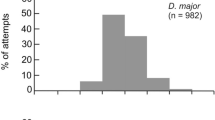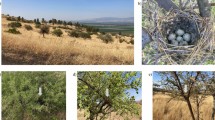Abstract
Populations of Lesser Spotted Woodpecker (Picoides minor) are decreasing in size, necessitating management strategies. However, data on the reproductive biology of this species are scarce. The aim of this study was to investigate the influence of timing of breeding and nestling diet on the reproductive success of the Lesser Spotted Woodpecker and thereby contribute to an understanding of the determinants influencing its reproductive success. During 6 study years between 1996–2003, we investigated various variables of reproductive success in a Lesser Spotted Woodpecker population in the Taunus low mountain range, Germany. We observed nestling feeding at breeding holes to assess the composition of nestling diet and how it changes during the season. Clutch size, number of fledglings as well as body mass of the nestlings declined with the start of egg laying. Pairs composed of individuals that had breed together in previous years started egg laying earlier than newly established pairs. Nestling diet consisted mainly of aphids, caterpillars, craneflies and wood-living larvae. The composition changed considerably within the breeding season in both early and late broods. However, early broods were provided with caterpillars more frequently, whereas late broods received wood-dwelling larvae more often. Our results suggest that Lesser Spotted Woodpeckers time their breeding so as to coincide with the early nestling stage with the highest availability of caterpillars, since this is the time of highest energy demand. Moreover, food availability declines during the breeding season, and the decline in reproductive performance seems to be an effect of this development.





Similar content being viewed by others
References
Arnold JM, Hatch JJ, Nisbet ICT (2004) Seasonal declines in reproductive success of the common tern Sterna hirundo: timing or parental quality? J Avian Biol 35:33–45
Bergmann F (1999) Langfristige Zunahme früher Bruten beim Teichrohrsänger (Acrocephalus scirpaceus) in einem südwestdeutschen Untersuchungsgebiet. J Ornithol 140:81–86
Both C, Bouwhuis S, Lessells CM, Visser ME (2006) Climate change and population declines in a long-distance migratory bird. Nature 441:81–83
Brinkhof MWG (1997) Seasonal variation in food supply and breeding success in European Coots Fulica atra. Ardea 85:51–65
Cramp S (1985) Handbook of the birds of Europe and the Middle East and North Africa. Oxford University Press, Oxford
Dias PC, Blondel J (1996) Breeding time, food supply and fitness components of Blue Tits Parus caeruleus in Mediterranean habitats. Ibis 138:644–649
Ens BJ, Kersten M, Brenninkmeijer A, Hulscher JB (1992) Territory quality, parental effort and reproductive success of Oystercatchers (Haematopus Ostralegus). J Anim Ecol 61:703–715
Ens BJ, Choudhury S, Black JM (1996) Mate fidelity and divorce in monogamous birds. In: Black JM (ed) Partnership in birds. Oxford University Press, Oxford, pp 344–401
Feeny P (1970) Seasonal changes in oak leaf tannins and nutrients as a cause of spring feeding by winter moth catterpillars. Ecology 51:565–581
Forslund P, Larsson K (1991) The effect of mate change and new partner’s age on reproductive success in the barnacle goose, Branta leucopsis. Behav Ecol 2:116–122
Gaston AJ (1997) Mass and date at departure affect the survival of Ancient Murrelet Synthliboramphus antiquus chicks after leaving the colony. Ibis 139:673–678
Glutz von Blotzheim UN, Bauer KM (1994) Columbiformes – Piciformes. Aula-Verlag, Wiesbaden
Green DJ, Cockburn A (2001) Post-fledging care, philopatry and recruitment in brown thornbills. J Anim Ecol 70:505–514
Grieco F (2002) How different provisioning strategies result in equal rates of food delivery: an experimental study of blue tits Parus caeruleus. J Avian Biol 33:331–341
Haig SM, Belthoff JR, Allen DH (1993) Population viability analysis for a small population of Red-Cockaded Woodpeckers and an evaluation of enhancement strategies. Conserv Biol 7:289–301
Harris MP, Buckland ST, Russell SM, Wanless S (1994) Post fledging survival to breeding age of shags Phalacrocorax aristotelis in relation to year, date of fledging and brood size. J Avian Biol 25:268–274
Höntsch K (2005) Der Kleinspecht (Picoides minor) – Autökologie einer bestandsbedrohten Vogelart im hessischen Vordertaunus. PhD thesis, University of Frankfurt, Germany
Ingold DJ (1994) Influence of nest-site competition between European Starlings and Woodpeckers. Wilson Bull 106:227–241
Klomp H (1970) Determination of clutch-size in birds – a review. Ardea 58:1–124
Kristin A (1992) Trophische Beziehungen zwischen Singvögeln und Wirbellosen im Eichen-Buchenwald zur Brutzeit. Ornithol Beob 89:157–169
McGraw KJ, Hill GE (2004) Mate attentiveness, seasonal timing of breeding and long-term pair bonding in the house finch (Carpodacus mexicanus). Behaviour 141:1–13
Mikusinski G, Angelstam P (1997) European woodpeckers and anthropogenic habitat change: a review. Vogelwelt 118:277–283
Monrós JS, Belda EJ, Barba E (2002) Post-fledging survival of individual great tits: the effect of hatching date and fledging mass. Oikos 99:481–488
Murphy MT (1986) Temporal components of reproductive variability in Eastern Kingbirds (Tyrannus tyrannus). Ecology 67:1483–1492
Naef-Daenzer B, Keller LF (1999) The foraging performance of great and blue tits (Parus major and P. caerulens) in relation to caterpillar development, and its consequences for nestling growth and fledging weight. J Anim Ecol 68:708–718
Naef-Daenzer L, Naef-Daenzer B, Nager RG (2000) Prey selection and foraging performance of breeding Great Tits Parus major in relation to food availability. J Avian Biol 31:206–214
Naef-Daenzer B, Widmer F, Nuber M (2001) Differential post-fledging survival of great and coal tits in relation to their condition and fledging date. J Anim Ecol 70:730–738
Nilsson JA, Svensson M (1993) Fledging in altricial birds – parental manipulation or sibling competition. Anim Behav 46:379–386
Nilsson SG, Olsson O, Svensson S, Wiktander U (1992) Population trends and fluctuation in Swedish woodpeckers. Ornis Svecica 2:13–21
Olsson O (1998) Through the eyes of a woodpecker: understanding habitat selection, territory quality and reproductive decisions from individual behaviour. PhD thesis, Lund University, Sweden
Pasinelli G (1999) Relations between habitat structure, space use and breeding success of the Middle Spotted Woodpecker Dendrocopos medius. PhD thesis, Universität Zürich, Switzerland
Perrins CM (1991) Tits and their caterpillar food supply. Ibis 133:49–54
Perrins CM, McCleery RH (1985) The effect of age and pair bond on the breeding success of Great Tits Parus major. Ibis 127:306–315
Price T, Kirkpatrick M, Arnold SJ (1988) Directional selection and the evolution of breeding date in birds. Science 240:798–799
Pyle P, Sydeman WJ, Hester M (2001) Effects of age, breeding experience, mate fidelity and site fidelity on breeding performance in a declining population of Cassin’s auklets. J Anim Ecol 70:1088–1097
Pynnönnen A (1943) Beiträge zur Kenntnis der Biologie finnischer Spechte, Teil II – Die Nahrung. Ann Zool Soc Zool-Bot-Fenn 9:1–59
Rossmanith E (2005) Breeding success, mating systems and population dynamics of the Lesser Spotted Woodpecker (Picoides minor): combing empirical and model investigations. PhD Thesis, University of Potsdam, Germany
Seki SI, Takano H (1998) Caterpillar abundance in the territory affects the breeding performance of Great Tit Parus major minor. Oecologia 114:514–521
Siikamäki P (1998) Limitation of reproductive success by food availability and breeding time in pied flycatchers. Ecology 79:1789–1796
Tiainen J (1985) Monitoring bird populations in Finland. Ornis Fenn 62:80–89
Török J (1990) Resource partitioning among three woodpecker species Dendrocopos spp. during breeding season. Holarctic Ecol 13:257–264
Van Balen JH (1973) A comparative study of the breeding ecology of the Great Tit Parus major in different habitats. Ardea 61:1–91
Verboven N, Visser ME (1998) Seasonal variation in local recruitment of great tits: the importance of being early. Oikos 81:511–524
Verhulst S, Vanbalen JH, Tinbergen JM (1995) Seasonal decline in reproductive success of the great tit – variation in time or quality. Ecology 76:2392–2403
Visser ME, van Noordwijk AJ, Tinbergen JM, Lessells CM (1998) Warmer springs lead to mistimed reproduction in great tits (Parus major). Proc R Soc Lond Ser B 265:1867–1870
Wesolowski T (1998) Timing and synchronisation of breeding in a Marsh Tit Parus palustris population from a primaeval forest. Ardea 86:89–100
Wesolowski T (2000) Time-saving mechanisms in the reproduction of Marsh Tits (Parus palustris). J Ornithol 141:309–318
Wiktander U (1998) Reproduction and survival in the lesser spotted woodpecker—effects of life history, mating system and age. PhD thesis, Lund University, Sweden
Wiktander U, Olsson O, Nilsson SG (2001a) Age and reproduction in lesser spotted woodpeckers (Dendrocopos minor). Auk 118:624–635
Wiktander U, Olsson O, Nilsson SG (2001b) Annual and seasonal reproductive trends in the Lesser Spotted Woodpecker Dendrocopos minor. Ibis 143:72–82
Yom-Tov Y, Ar A (1993) Incubation and fledging durations of Woodpeckers. Condor 95:282–287
Acknowledgements
We wish to thank all of the field helpers for their dedication and Ulf Wiktander for comments on an earlier version of the manuscript. We thank the Deutsche Wildtierstiftung for financial support. The study was sponsored by the Scholarship Programme of the German Federal Environment Foundation (DBU). All work carried out within the framework of this project complies with the current laws of Germany.
Author information
Authors and Affiliations
Corresponding author
Additional information
Communicated by F. Bairlein.
Rights and permissions
About this article
Cite this article
Rossmanith, E., Höntsch, K., Blaum, N. et al. Reproductive success and nestling diet in the Lesser Spotted Woodpecker (Picoides minor): the early bird gets the caterpillar. J Ornithol 148, 323–332 (2007). https://doi.org/10.1007/s10336-007-0134-4
Received:
Revised:
Accepted:
Published:
Issue Date:
DOI: https://doi.org/10.1007/s10336-007-0134-4




